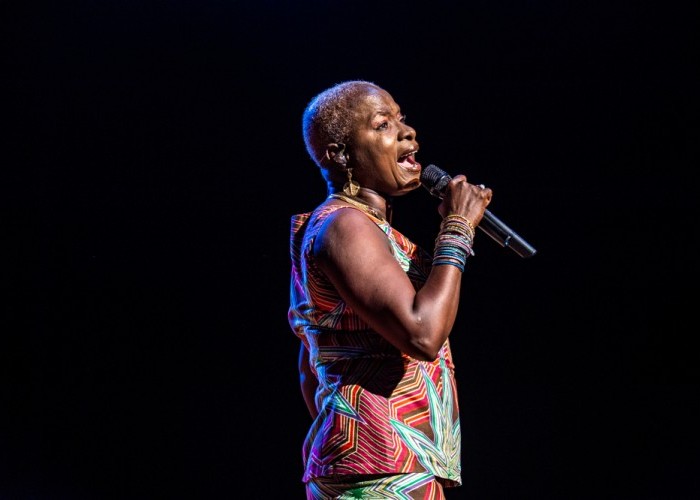Apr 2, 2024 12:59 PM
Saxophonist, Sonic Explorer Casey Benjamin Dies at 45
Casey Benjamin, the alto saxophonist, vocalist, keyboardist and producer who stamped his distinctive sounds on the…

Singer Angélique Kidjo performs portions of Talking Heads’ Remain In Light on Aug. 6 at Ravinia in Highland Park, Illinois.
(Photo: Russell Jenkins/Ravinia Festival)Angélique Kidjo traversed continents before she heard Talking Heads’ Remain In Light. But her Aug. 6 concert at Ravinia in Highland Park, Illinois, made it sound as if she didn’t travel far to claim these songs for herself.
The Beninese singer first listened to the New York rock group’s 1980 album around the time she immigrated to Paris in 1983. Much of it sounded familiar, as Talking Heads had layered African rhythms into the production, along with funk and some early hip-hop conceits. Territorial and spiritual journeys also inform its lyrics. Kidjo fully absorbed the album more recently and released her interpretation, also titled Remain In Light (Kravenworks). This version—sung in English, Fon and Yoruba—emphasized personal, as much as global, themes. But the new take on the 1980 recording departed from its predecessor in some pronounced ways during the recent performance.
When Talking Heads released Remain In Light, the album steered away from rock music’s prevalent spotlight on soloists. Individual instruments and David Byrne’s voice became subsumed by the rhythmic changes and ensemble dynamic. But when Kidjo sings, her powerful tone and magnetic charisma are never far from the focus. That was especially clear at Ravinia, but her star power also came through as an array of musical ideas framed her voice.
Her determined delivery and the accompanying quintet’s versatility drove the opening “Born Under Punches.” Kidjo’s urgency projected strength without letting amplification drown out percussionist Edgardo “Yayo” Serka and drummer Magatte Sow’s shifting accents. Meanwhile on that piece, as well as “Crosseyed And Painless,” guitarist Dominic James and bassist Michael Olatuja responded to Kidjo with interlocking lines that recalled West African highlife.
As the singer’s performance added more empathy to the narration of “Listening Wind,” Serka’s mallets pushed her forward, as if he echoed a nervous heartbeat in this song about a terrorist attack. Similarly, keyboardist Jason Lindner revealed continuously shifting effects as Kidjo free-associated a rap on “Houses In Motion.”
Some songs felt as if they were composed with Kidjo in mind, but here, too, she emphasized her group as much as herself. Singing “The world moves on a woman’s hips” (from “The Great Curve”), her movements directed the band, especially Serka’s talking drum and Linder’s synthesizer lines, which resembled those of the late Talking Heads associate Bernie Worrell. Kidjo also took on a ministerial role for “Once In A Lifetime,” as the group’s upbeat response stressed the universal and she repeated the pronoun “you.”
When Kidjo departed from Remain In Light, just a few songs highlighted her wide vocal and emotional range. Kidjo performed her haunting “Cauri” with just James’ guitar accompaniment, as the song decries the worldwide abuse of young girls. Later on, she paid tribute to the late Miriam Makeba (calling the South African hero “my musical mother”) in a frenzied version of her 1960s hit “Pata Pata.”
Kidjo went back to the Talking Heads songbook for her encore, a cool delivery of the group’s “Burning Down The House” (from the 1983 album Speaking In Tongues). As the song itself compelled the audience to dance while Lindner made the most of his laptop’s sound effects, she kept her vocal delivery mostly understated. That framework made her sudden shout, on the line “fighting fire with fire,” all the more striking and, ultimately, joyous.
Nigerian Afrobeat bandleader Femi Kuti’s opening set presented a similar spirit. His group, Positive Force, reflects the musical legacy of Femi’s father, Fela Kuti. A full horn section responded to keyboard vamps and interlocking polyrhythms. Just like in the ’70s and ’80s, the voices and choreography of backing female vocalists added their own commentary. The bandleader also continued the tradition of using his performance to critique global crises—at Ravinia he decried war, climate change and the plight of refugees. Fela Kuti was frequently a caustic figure onstage, but at Ravinia, Femi Kuti sounded genial while singing or playing elongated lines on alto saxophone. And his reach for a musical mantle never veered far from that gentle touch. DB

Benjamin possessed a fluid, round sound on the alto saxophone, and he was often most recognizable by the layers of electronic effects that he put onto the instrument.
Apr 2, 2024 12:59 PM
Casey Benjamin, the alto saxophonist, vocalist, keyboardist and producer who stamped his distinctive sounds on the…

“He’s constructing intelligent musical sentences that connect seamlessly, which is the most important part of linear playing,” Charles McPherson said of alto saxophonist Sonny Red.
Feb 27, 2024 1:40 PM
“I might not have felt this way 30 to 40 years ago, but I’ve reached a point where I can hear value in what people…

Albert “Tootie” Heath (1935–2024) followed in the tradition of drummer Kenny Clarke, his idol.
Apr 5, 2024 10:28 AM
Albert “Tootie” Heath, a drummer of impeccable taste and time who was the youngest of three jazz-legend brothers…

“Both of us are quite grounded in the craft, the tradition and the harmonic sense,” Rosenwinkel said of his experience playing with Allen. “Yet I felt we shared something mystical as well.”
Mar 12, 2024 11:42 AM
“There are a few musicians you hear where, as somebody once said, the molecules in the room change. Geri was one of…

Larry Goldings’ versatility keeps him in high demand as a leader, collaborator and sideman.
Feb 21, 2024 10:45 AM
Are you having any fun? Larry Goldings certainly is. Consider just two recent examples:
Scene 1: “If anyone had…